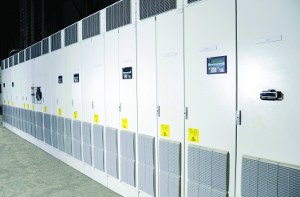 |
| January 08, 2013 | Volume 09 Issue 01 |
Designfax weekly eMagazine
Archives
Partners
Manufacturing Center
Product Spotlight
Modern Applications News
Metalworking Ideas For
Today's Job Shops
Tooling and Production
Strategies for large
metalworking plants
Inside Look:
Updated Apache and Black Hawk helicopter transmission test stand
A test stand builder collaborates with Siemens Industry, Inc. on variable speed drives and motors to affect green, lean solutions for testing helicopter powertrains at Department of Defense customer; over 20 test stands reduced to five.

Members of a UH-60 Black Hawk helicopter crew, assigned to 2nd Battalion, 25th Aviation Regiment, 25th Combat Aviation Brigade, come in for a dust landing with Soldiers from 1st Battalion, 25th Stryker Brigade Combat Team, during an air assault training mission led by the Kandahar Air Wing and Afghan National Army in Kandahar Province, Afghanistan, Feb. 29, 2012. [Photo by U.S. Army Sgt. Daniel Schroeder]
RedViking, located in Plymouth, MI, made its mark in automotive power transmission test stands, beginning in 1981 as Superior Controls. Today, the company is providing multi-disciplinary engineering and equipment construction services to major corporations such as Caterpillar, GE, Boeing, General Motors, and others. Spun off in 2010, RedViking designs and builds a variety of powertrain test equipment, metrology, and production solutions for government and commercial OEMs alike.
For a recent Department of Defense (DoD) customer, RedViking was presented with a challenge that involved an existing bank of over 20 individual test stands used for dynamic testing of performance factors on helicopter transmissions, primarily in the Apache and Black Hawk classes. The existing test stands ranged from 20 to 50 years in age and had been built with single-purpose functionality. This scenario resulted in constantly increasing maintenance requirements for the customer, plus excessive power consumption and plant floor space capacity overload. The test stands suffered from a lack of readily available spare parts, required unique training to operate each stand, and did not produce the desired level of data for analysis.
When a unit test was required, the test article would be built up and dressed within the envelope of the test stand, fully connected, then tested, disconnected, and removed from the work cell. This procedure resulted in extremely long downtime impact on the customer's equipment utilization, with various corresponding logistic challenges. Coupled with the age of the equipment and the excess power used by the older equipment, this situation presented the RedViking engineers with a series of hurdles to overcome.
New testing system requirements included better compilation of test data, automatic closed-loop operation of the machinery, true speed and torque measurement -- with a local test executive as the main operator interface to the test machine -- and a standardized control platform to allow easier operator cross-training on the equipment.

New RedViking test stand for evaluating performance on transmissions from multiple helicopter OEMs.
To accomplish greater efficiency in the utilization of these test stands, a series of workpiece carriages was designed, allowing the units under test (UUT) to be mounted and staged outside the envelope of the test stand and then brought into the work cell for faster connection, test, disconnect, and exit. RedViking terms these devices transportable test fixtures (TTFs), which automate shaft connections, clamping, and positioning, as well as providing 360-degree access to the UUT. This design provides significantly greater efficiency as well as a safe and ergonomic operator environment. As RedViking explained, hours of test setup time were reduced to minutes.
Jason Stefanski, RedViking controls and software manager, and his team devised an entirely new, modular software system and common human machine interface (HMI) platform for all five test stands, with a common user interface and plug-in architecture, comprising common function blocks, I/O coding, and CAT 4 safety functions. This design approach allows the software to be easily configured to accommodate the various transmission models being tested.
Once the test article in the TTF is automatically positioned and attached, RFID tags on the TTF identify both the article and its test profile configuration and communicate them to the test executive.
All test profiles are generated and stored offline, with modifications made by the customer's engineering staff outside the test cells. Test profiles are then linked to the UUT type and model data for further system integrity.

SINAMICS "Drive Alley" houses the main drives for the RedViking test stand.
The main software feature of the test machines is the ability to execute a fully automated, repeatable, and traceable test. To provide this functionality, RedViking has developed a test sequence set (TSS) editor, allowing all parameters to be set by the customer and downloaded to a test executive from a localized laptop, thus eliminating the need to modify validated machine code. The TSS editor provides the customer with adaptability to easily modify future or existing test profiles.
After a thorough review of the potential suppliers for the power components and controls on these new test stands, Siemens Industry's Drive Technologies Division was chosen to provide the motors and AC flux vector drives packages with regenerative braking for increased energy efficiency. RedViking worked closely with Siemens to devise an AC system, utilizing the regenerative technology found in Sinamics drives with 480-V and 690-V standards. Stefanski remembers a number of field trips to Siemens customers to investigate the performance and application specifics of regen drives used with 3,000-hp motors.
The use of Siemens regenerative braking technology allows a system to recover power, minus the parasitic losses. Conventional dynamic load testing requires loading to occur via an eddy current or fluid brake system, which requires additional energy, maintenance, and up-front capital investment. In more innovative industrial environments, according to Siemens, Sinamics regenerative drive technology can enable energy savings of 40 percent or more.
With a common DC bus architecture, this allows for only one AC-to-DC conversion in the motoring direction, and the regenerative braking power goes straight to another inverter, which is motoring via the common DC bus link. This method eliminates two conversion points where energy would be lost, which increases the overall efficiency. In addition, the common bus solution paired with the active front end (AFE) has the ability for power factor correction, which will further increase the overall savings of a common bus system. All AFE drives allow for unity power factor and low total harmonic distortion (THD) that meets IEEE 519 harmonic standards. This means these drive systems can improve the present power factor displacement in a customer's facility.
RedViking estimates that a test on the Main Transmission Flexible Test System, while running at full capacity, will cost approximately $400 less per hour to operate than current comparable systems. With improvements over the conventional, non-regen testing process, the RedViking Main Transmission Test System could generate approximately $500,000 in annual power savings.
For this project, Siemens Industry, Inc. supplied its high-performance asynchronous Simotics 1PL6 and 1RN4 motors, the largest being 3,000 hp, to power the various mechanisms on the RedViking test stands. When in operation, these motors simulate the power generated by the helicopter's jet engines, in addition to simulating the loading of the main rotor and tail output blades. This allows RedViking to test the helicopter transmission components to the full speed and torque requirements as specified by the military with very precise closed-loop control.

RedViking Controls and Software Manager Jason Stefanski at the main transmission flexible test module.
On the Tail and Intermediate Gearbox Flexible Test Module, it was determined that the use of two more Siemens Simotics motors was less expensive and more efficient than the previous test stand's gearbox design. This solution involves multiple motor connections to an output variable frequency drive (VFD) with auxiliary connections, thereby eliminating the need for additional VFDs.
Stefanski notes that one of the reasons that Siemens was selected for this project is their global support structure combined with a U.S. base of manufacturing. RedViking prides itself on designing and building systems in the U.S. and seeks out vendors who build their products in the U.S. as well.
"We knew we were building these test stands to validate the performance of military helicopters that see wartime action," says Joshua Gibbs, RedViking manufacturing coordinator. "We take it very personally at RedViking to ensure these systems protect man and machine alike, as well as provide the ultimate in test validation." Gibbs also says that the substantial energy savings and operational efficiencies realized by the RedViking customer gave the entire team considerable pride of accomplishment on this project. RedViking currently performs both DO and DX contracts for the military and its subcontractors.
Source: Siemens Industry, Inc.
Want more information? Click below.
Published January 2013
Rate this article
View our terms of use and privacy policy
